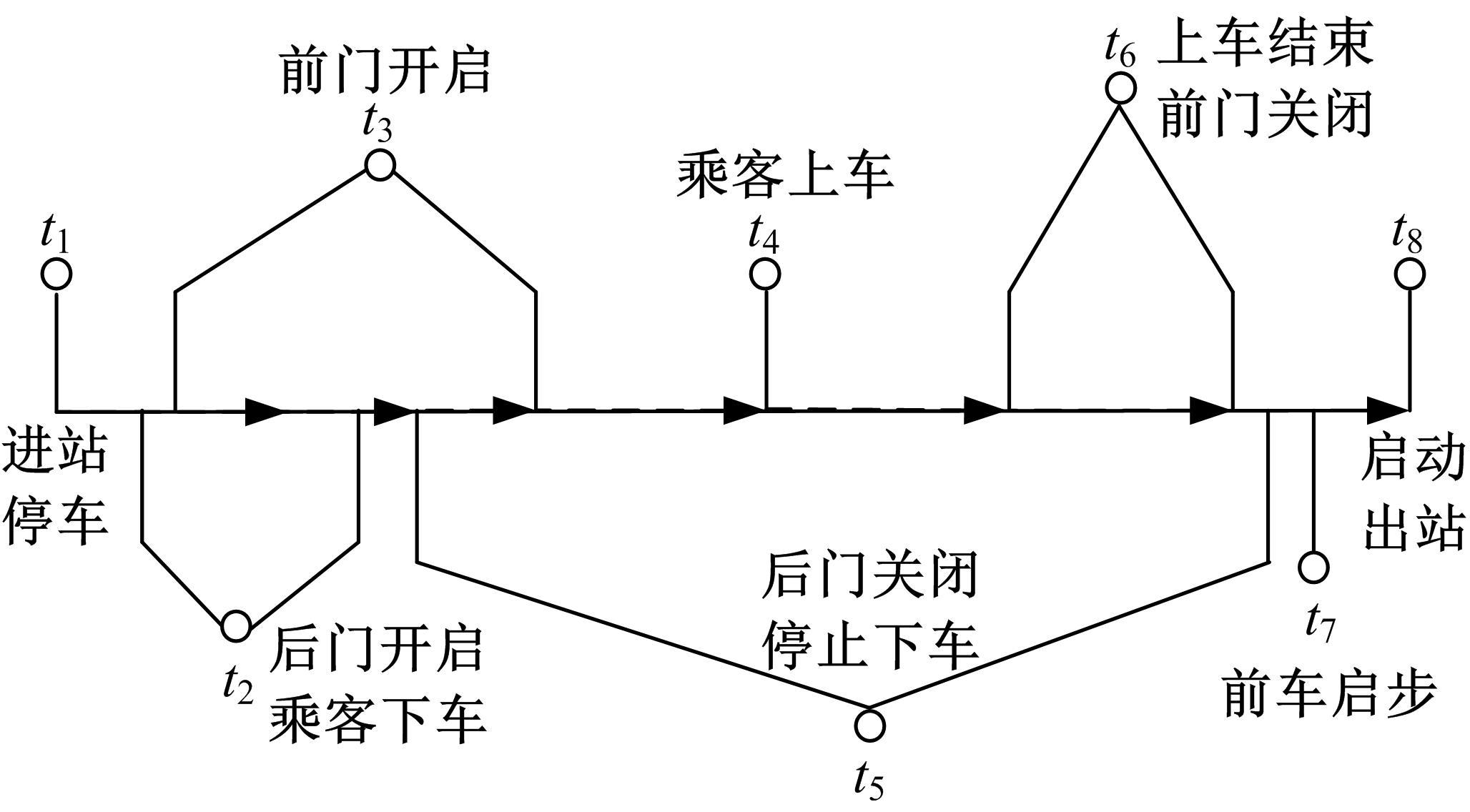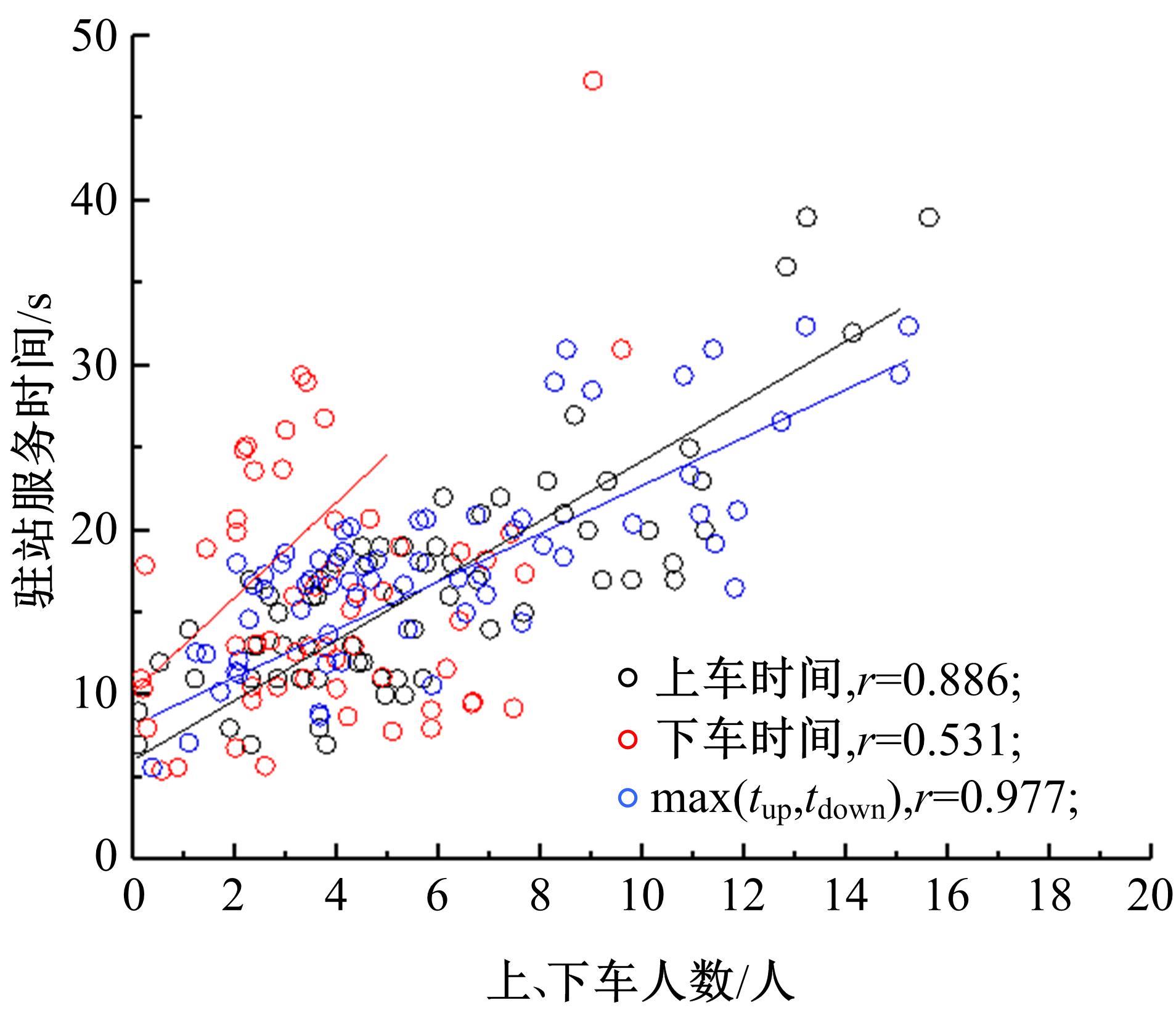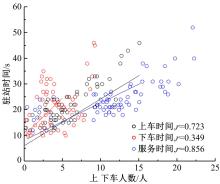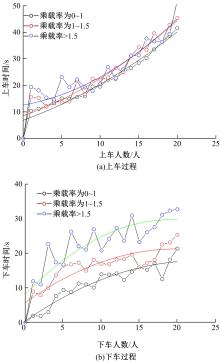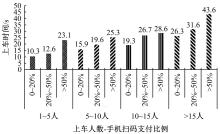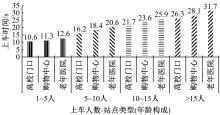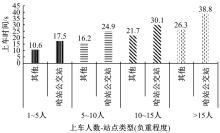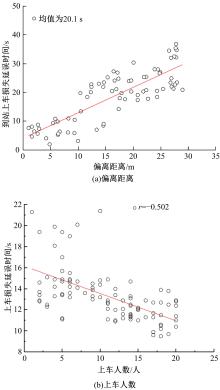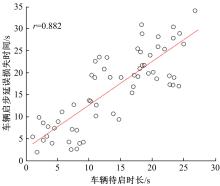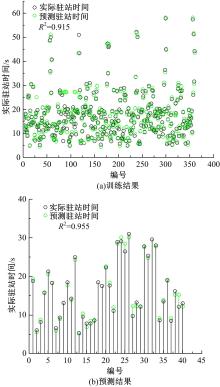吉林大学学报(工学版) ›› 2021, Vol. 51 ›› Issue (6): 2031-2039.doi: 10.13229/j.cnki.jdxbgxb20200676
• 交通运输工程·土木工程 • 上一篇
城市公交车辆驻站时间特征分析及预测
- 东北林业大学 交通学院,哈尔滨 150040
Characteristics analysising and prediction of dwelling time of urban bus
Shi-jun YANG( ),Yu-long PEI(
),Yu-long PEI( ),Heng-yan PAN,Guo-zhu CHENG,Wen-hui ZHANG
),Heng-yan PAN,Guo-zhu CHENG,Wen-hui ZHANG
- School of Traffic and Transportation,Northeast Forestry University,Harbin 150040,China
摘要:
为准确分析公交车辆的驻站时间特征,并对其进行预测,本文对公交车辆驻站过程中的时间构成进行分析,引入了驻站服务时间的概念,用于量化车辆驻站过程中乘客上、下车的时长。根据人工调查数据分析,得出上车时间与下车时间是驻站服务时间与驻站时间的影响因素;与下车时间相比,上车时间与驻站服务时间、驻站时间的相关性更强,且两者的最大值与驻站服务时间、驻站时间的相关性最强。分析了车内拥挤状态对乘客上车时间、下车时间的影响,同时分析了乘客的付费方式、年龄、负重情况对上车时间的影响。引入车辆停靠偏离距离的概念,分析了驻站过程中车辆停靠偏离程度、上车人数对上车延误损失时间的影响,以及车辆待启时长对出站启步延误损失时间的影响。基于上述分析结果,构建了具有8个输入层的BP神经网络的驻站时间预测模型,模型的训练结果和预测结果的拟合优度分别为0.915和0.955,具有良好的预测作用。
中图分类号:
- U491.1
| 1 | Estrada M, Trapote C, Roca M, et al. Improving bus travel times with passive traffic signal coordination[J]. Transportation Research Record, 2009, 2111(1): 68-75. |
| 2 | Fan W D, Machemehl R B. Do transit users just wait for buses or wait with strategies some numerical results that transit planners should see[J]. Transportation Research Record, 2009, 2111(1): 169-176. |
| 3 | Peng Zhong-ren, Lyndem E, Chen Wei-ya. Understanding transit service gaps[C]∥The 89th Transportation Research Board Annual Meeting, Washington DC, 2009: 1-18. |
| 4 | Khoo H L. Statistical modeling of bus dwell time at stops[J]. Journal of the Eastern Asia Society for Transportation Studies, 2013, 10: 1489-1500. |
| 5 | Chen Shao-kuan, Zhou Rui, Zhou Yang-fan, et al. Computation on bus delay at stops in Beijing through statistical analysis[J]. Mathematical Problems in Engineering, 2013, 2013(1971): No.745370. |
| 6 | Tirachini A. Bus dwell time: the effect of different fare collection systems,bus floor level and age of passengers[J]. Transportmetrica A: Transport Science, 2013, 9(1):28-49. |
| 7 | Arhin S A, Noel E C. Predicting dwell time by bus stop type and time of the day[J]. Journal of Civil & Environmental Engineering, 2015, 5(5): No.1000189. |
| 8 | 梁士栋,赵淑芝,马明辉,等. 路段直线式公交站点对公交车延误的影响[J]. 吉林大学学报:工学版,2016,46(6):1807-1817. |
| Liang Shi-dong, Zhao Shu-zhi, Ma Ming-hui, et al. Impacts of linear bus stop on bus delays[J]. Journal of Jilin University(Engineering and Technology Edition), 2016, 46(6): 1807-1817. | |
| 9 | 王旭,陈旭梅,寇伟彬,等. 公交站点停靠时间预测模型研究[J]. 交通信息与安全,2016,34(2):55-61. |
| Wang Xu, Chen Xu-mei, Kou Wei-bin, et al. A prediction model of bus dwelling time at the stops[J]. Journal of Transport Information and Safety, 2016, 34(2): 55-61. | |
| 10 | 吕伟,李志红,赵彩虹,等. 城市公交车停靠时间特征的观测试验与实证研究[J]. 公路交通科技,2019,36(11):90-96. |
| Lü Wei, Li Zhi-hong, Zhao Cai-hong, et al. Observation experiment and empirical study on parking time characteristics of city buses[J]. Journal of Highway and Transportation Research and Development, 2019, 36(11): 90-96. | |
| 11 | 邓媚,李春达. 不同站台环境下公交车停靠时间的动态预测模型[J]. 重庆交通大学学报:自然科学版,2019,38(12):105-109. |
| Deng Mei, Li Chun-da. Dynamic prediction model of bus dwell time under different station conditions[J]. Journal of Chongqing Jiaotong University(Natural Science), 2019, 38(12): 105-109. | |
| 12 | 朱文韬,钱国敏,马东方,等. 考虑路口上游停靠站影响的公交延误模型[J]. 浙江大学学报: 工学版,2020,54(4):796-803, 815. |
| Zhu Wen-tao, Qian Guo-min, Ma Dong-fang, et al. Bus delay model considering influence of stop at upstream of intersection[J]. Journal of Zhejiang University(Engineering Science), 2020, 54(4): 796-803, 815. | |
| 13 | 马尚萱. 常规公交站点停靠时间分析与预测方法[D]. 南京:东南大学交通学院,2016. |
| Ma Shang-xuan. Bus dwell time analysis and prediction methods[D]. Nanjing: School of Transportation, Southeast University, 2016. | |
| 14 | 陈亮,冯柳,李巧茹. 考虑在车感知价值的公交发车间隔计算模型[J]. 哈尔滨工业大学学报,2018,50(3):150-155. |
| Chen Liang, Feng Liu, Li Qiao-ru. Bus departure interval model considering on-bus perceived value[J]. Journal of Harbin Institute of Technology, 2018, 50(3): 150-155. | |
| 15 | Group KFH. Transit Capacity and Quality of Service Manual[M]. 3th ed. Washington DC: TRB, 2013. |
| 16 | 姜桂艳,刘彬,隋晓艳. 基于IC卡收费系统的公交客流信息实时采集方法[J]. 吉林大学学报:工学版,2016,46(4):1076-1082. |
| Jiang Gui-yan, Liu Bin, Sui Xiao-yan. Real time information collection of passenger flow in public transportation based on bus IC card charging system[J]. Journal of Jilin University(Engineering and Technology Edition), 2016, 46(4): 1076-1082. | |
| 17 | 刘莹,于淼,刘阳. 基于乘客感知的公交车线路服务质量评价模型[J]. 东北大学学报:自然科学版,2019,40(5):750-755. |
| Liu Ying, Yu Miao, Liu Yang. Evaluation model of bus Route service quality based on passengers perceptions[J]. Journal of Northeastern University(Natural Science), 2019, 40(5): 750-755. | |
| 18 | Liu Y. An improved AHP and BP neural network method for service quality evaluation of city bus[J]. International Journal of Computer Applications in Technology, 2018, 58(1): 37-44. |
| 19 | 罗菊,方照东,袁泉.基于集成神经网络的信道估计方法研究[J].重庆邮电大学学报:自然科学版,2020, 32(6): 969-975. |
| Luo Ju, Fang Zhao-dong, Yuan Quan. Research on channel estimation method based on integrated neural network[J]. Journal of Chongqing University of Posts and Telecommunications(Natural Science Edition), 2020, 32(6): 969-975. | |
| 20 | 李娜娜, 胡坚剑, 顾军华, 等. 深度置信网络优化模型在人才评价中的应用[J]. 计算机工程, 2020, 46(2): 80-87, 102. |
| Li Na-na, Hu Jianjian, Gu Jun-hua, et al. Application of optimized deep belief network model in talent evaluation[J]. Computer Engineering, 2020, 46(2): 80-87, 102. | |
| 21 | 张飞,雒江涛,何宸,等. NDN中基于神经网络的兴趣洪泛攻击综合防御方案[J].重庆邮电大学学报:自然科学版, 2020, 32(2): 177-184. |
| Zhang Fei, Luo Jiang-tao, He Chen,et al. Evaluation model of bus Route service quality based on passengers perceptions[J]. Journal of Northeastern University(Natural Science), 2020, 32(2): 177-184. |
| [1] | 孙宝凤,姜源,郑黎黎,崔万坤,任欣欣. 变覆盖半径下城市轨道交通维护保障网络设计模型[J]. 吉林大学学报(工学版), 2020, 50(2): 526-534. |
| [2] | 陈磊,王江锋,谷远利,闫学东. 基于思维进化优化的多源交通数据融合算法[J]. 吉林大学学报(工学版), 2019, 49(3): 705-713. |
| [3] | 刘东亮, 王秋爽. 基于NGSIM数据的车辆瞬时速度获取方法[J]. 吉林大学学报(工学版), 2018, 48(1): 330-335. |
| [4] | 王德军, 吕志超, 王启明, 张贤达, 王子健. 基于汽缸压力辨识的发动机失火故障诊断[J]. 吉林大学学报(工学版), 2017, 47(3): 917-923. |
| [5] | 黄璇, 郭立红, 李姜, 于洋. 改进粒子群优化BP神经网络的目标威胁估计[J]. 吉林大学学报(工学版), 2017, 47(3): 996-1002. |
| [6] | 郭应时, 付锐, 赵凯, 马勇, 袁伟. 驾驶人换道意图实时识别模型评价及测试[J]. 吉林大学学报(工学版), 2016, 46(6): 1836-1844. |
| [7] | 高明亮, 于生宝, 郑建波, 徐畅, 张堃, 栾卉. PSBP在高密度电阻率法二维反演中的应用[J]. 吉林大学学报(工学版), 2015, 45(6): 2026-2033. |
| [8] | 李寿涛, 田微, 郭鹏程, 马用学, 张浩, 王楠. 基于模糊自适应的BP神经网络动态行驶车辆车长测算[J]. 吉林大学学报(工学版), 2015, 45(6): 1881-1886. |
| [9] | 闫楚良, 郝云霄, 刘克格. 基于遗传算法优化的BP神经网络的材料疲劳寿命预测[J]. 吉林大学学报(工学版), 2014, 44(6): 1710-1715. |
| [10] | 陈莉, 孙永海, 付天宇, 丁健峰. 羊肚菌胞外多糖快速估测方法[J]. 吉林大学学报(工学版), 2014, 44(2): 567-572. |
| [11] | 侯阿临, 廖庆, 靳志娟, 陈娟, 耿莹. 计算全息图的人工神经网络压缩算法[J]. 吉林大学学报(工学版), 2013, 43(增刊1): 21-24. |
| [12] | 司建波, 杨芳, 郭蔚莹, 姚燕. 基于BP神经网络的两阶段疾病预测模型[J]. 吉林大学学报(工学版), 2013, 43(增刊1): 481-484. |
| [13] | 王改革, 郭立红, 段红, 刘逻, 王鹤淇. 基于萤火虫算法优化BP神经网络的目标威胁估计[J]. 吉林大学学报(工学版), 2013, 43(04): 1064-1069. |
| [14] | 王国磊, 陈恳, 陈雁, 朱丽, 王力强, 颜华. 变参数下的空气喷枪涂层厚度分布建模[J]. 吉林大学学报(工学版), 2012, 42(01): 188-192. |
| [15] | 张祥合, 王丹, 任露泉, 赵宏伟. 基于多维空间仿生信息学的目标识别新算法[J]. 吉林大学学报(工学版), 2011, 41(增刊2): 269-274. |
|
||

